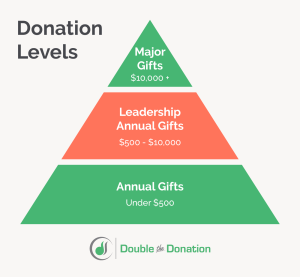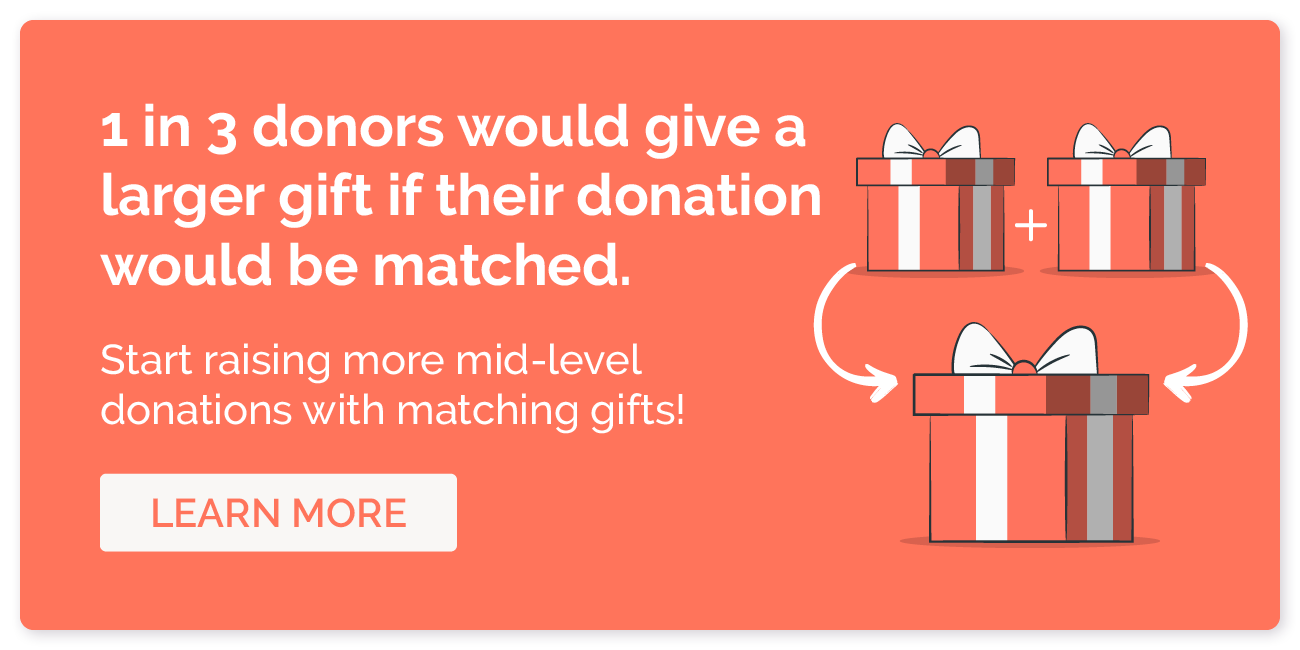How to Raise More: The Truth About Leadership Annual Giving
Larger donations play important roles in fundraising success, especially since major gifts of more than $1,000 account for 85% of the average nonprofit’s revenue. The challenge here, though, is that many nonprofits don’t (or can’t) consistently pursue major gifts while juggling many other day-to-day needs and goals.
But there’s a surefire way to consistently secure larger contributions: a leadership annual giving program.
Leadership annual giving unlocks fundraising security with recurring and substantial donations to your nonprofit. This guide explains everything you need to know, broken down into the following sections:
- What is leadership annual giving?
- Why launch a leadership annual giving program?
- How to start mid-level fundraising
- Leadership annual giving tactics
Before you can tap into this powerful fundraising source, you’ll need a thorough understanding of what it is. With that in mind, let’s define leadership annual giving.
What is leadership annual giving?
Leadership annual giving refers to a nonprofit’s largest repeating gifts, typically falling between $500 and $10,000. These leading annual gifts tend to fall in an organization’s mid-level range but largely depend on the giving levels of your organization’s donors. Consider the example to the left of how these donation levels might be categorized.
Leadership annual gifts not only guarantee substantial and sustained support for your organization, but they open the gateway to request larger gifts in the future when you properly steward your relationships with these loyal donors. Plus, there are numerous other benefits of incorporating these gifts into your fundraising strategy.
Why launch a leadership annual giving program?
You may already know that donor retention is more cost-effective than acquisition, but the value of strong retention goes far beyond just the cost of obtaining their support.
Around 60% of repeat donors will give again, meaning those who subsequently give to your organization may be a reliable source of support for the long term. Once you’ve already captured a donor’s attention and gained their affinity for your cause, it will be much easier to ask for increased gift amounts or consistent donation frequencies.
To communicate the need for mid-level giving, however, your nonprofit must develop an organized approach to leadership annual giving. An overwhelming majority of donors give less than $500, with the breakdown of donations falling into the following categories according to the Fundraising Effectiveness Project:
- 53.7% of donors give $100 or less
- 29.9% give $101-$500
- 13.8% give $501-$5,000
- 2.3% give $5,000-$50,000
- 0.3% give over $50,000
With such a low percentage of donors engaging in mid-level giving, a standardized approach to leadership annual giving is vital to moving donors into this category. Let’s explore the practical steps your organization can take to acquire mid-level gifts.
How to start mid-level fundraising
Thousands of guides exist about securing smaller gifts or chasing major donations. But this advice skips a critical middle step, which is to target leadership annual giving in your fundraising appeals for more sustainable fundraising.
Similar to gifts of other sizes, leadership annual giving requires donor cultivation. Follow these steps to engage supporters in mid-level giving.
1. Identify mid-level giving prospects.
As with many aspects of your fundraising strategy, leadership annual giving starts with your donor data. To narrow your fundraising appeals, you must first identify supporters who might be willing and able to give at this level and frequency. Some data points to guide your prospect research include:
- Philanthropic indicators: These factors indicate donors’ willingness to give to your organization, including previous donations to your nonprofit, involvement with other organizations that have similar causes, or personal interests that align with your mission.
- Wealth indicators: These factors indicate donors’ ability to give to your organization, including real estate ownership, business affiliations, stock ownership, and other signs of financial ability.
To streamline your data collection, organization, and analysis, consider using a data appending service. Appending data helps ensure your database is accurate and complete, giving you the best possible overview of your prospects.
2. Cultivate donor relationships.
Once you’ve identified mid-level giving prospects, it’s time to form relationships with each of them. This involves educating potential donors about your nonprofit, but also getting to know more about each supporter to build a connection between your organization and the individual.
Develop a donor engagement plan for prospective donors that includes:
- Personalizing communications by including donors’ names and information about their engagement.
- Being transparent about how donations are used and what your nonprofit is doing to fulfill its mission.
- Offering insider benefits, such as tours of your nonprofit’s facilities or invite-only events.
Data is still important in the stewardship phase since you’ll constantly learn more about your supporters and use this information to strengthen relationships with them. By cultivating relationships with potential mid-level donors, your nonprofit will also build a trustworthy and impactful reputation in the community. This way, you’ll have a better chance of attracting donors when the leadership annual giving cycle restarts.
3. Make your mid-level fundraising appeals.
Your direct ask for donations must be specifically targeted to leadership annual giving. Whether you reach out via email, design a dedicated donation page, or make your appeal on any other channel, be sure to include the following:
- Background information: On any occasion, donors want to know how their gifts will be used. But because of the popularity of smaller, one-time gifts, they may not know what leadership annual giving is or why it’s important. Along with details about your nonprofit, the reason for the fundraiser, and the impact you’re able to make with donations, provide a brief explainer about mid-level giving and why it’s important.
- Giving flexibility: Remember to appeal to donors’ preferences to make giving as easy as possible for them. If you don’t have sufficient data from your donors to guide your appeals, use general statistics in the meantime. For example, 94% of recurring donors prefer giving monthly, meaning you should offer the ability to subscribe to monthly gifts to appeal to more donors.
- Various involvement opportunities: Even if you’ve done all your research and crafted the perfect appeal to the ideal prospect, they may say no. And that’s okay! If the supporter can’t commit to leadership annual giving right now, you should still secure their engagement with your organization through another form of giving, such as volunteer opportunities or fundraising event attendance.
While your fundraising appeals should take a multi-channel approach, your best bet is to segment donors based on their communication preferences to reach out to each donor on the channel they prefer. Other shared characteristics, like donors’ interests or occupations, can be used to further segment donors and send messages that are as personalized as possible.
4. Steward mid-level donors.
Because a central component of leadership annual giving is recurring gifts, your nonprofit’s continual stewardship of these donor relationships is crucial to securing continued support. A few ways you can continuously engage donors, even after they give, include:
- Sharing your appreciation for their support.
- Sending impact reports and other updates about what your nonprofit is doing.
- Telling beneficiaries’ stories.
Stewardship solidifies these relationships to ensure long-term support, but may also enable your nonprofit to upgrade these donors over time. This is how you build an organic major giving pipeline, which is extremely important for nonprofits but difficult to do. For example, you might transition a leadership annual giving donor into a major gift donor after establishing a relationship with that supporter.
Leadership annual giving tactics
If you’re ready to increase your leadership annual giving, there are a few best practices you can follow to develop the process.
1. Offer matching gifts.
A classic way to double the amount your nonprofit raises, matching gifts can increase both your mid-level revenue and the likelihood that a donor will give to your leadership annual giving campaign. Here’s how:
- More revenue: Eligible donors will have their donations matched by their employers, meaning your nonprofit receives two donations instead of just one. Plus, 1 in 3 donors say they would make larger donations if they knew their gift would be matched.
- More donations: When donors find their contributions could be doubled at no extra cost to them, they’ll feel they can make twice the impact and be more excited to give!
Simply let donors know about the opportunity when they donate so they can find out if they’re eligible through their employer. A tool that offers auto-submission, like 360MatchPro, can further simplify the process by enabling donors to automatically submit a match request to their employer. For more information on this tool, check out the video below:
Be sure to check donors’ eligibility before reaching out to mid-level or major donors about matching gifts. After all, donors can’t donate matched gifts if their employers don’t offer the program. Even if their employers offer matching as part of their CSR initiatives, donors may be restricted to donation maximums.
2. Launch a giving society.
Providing specific giving amounts is a surefire way to simplify the donation process for any level of giving. However, it can also incentivize leadership annual giving by adding an element of prestige to the donation.
For example, establish 4-5 tiers based on giving amounts, such as one tier for $500-$1,000 gifts and another for $1,001-$2,000 gifts. Then, assign names to each tier and promote the benefits for each, such as invite-only events or tours of your nonprofit’s facilities.
This reward system incentivizes donors to give specific amounts in exchange for achieving a status and receiving the benefits.
3. Track your progress.
Analyze the efficiency of your leadership annual giving campaign by using fundraising data and setting incremental goals. For example, you might set a goal number of prospects to convert into mid-level donors or a specific amount to raise by a deadline.
Marketing key performance indicators (KPIs) are similarly important to track, such as website traffic and cost per conversion. This can help you identify your most successful marketing tactics to convert prospects into donors.
4. Offer non-cash giving options.
97% to 99% of all wealth in the United States is held in assets like stocks and real estate, meaning your donors may not have cash to contribute to your leadership annual giving program. To make this level of giving accessible to as many donors as possible, encourage donors to give non-cash gifts, such as:
- Gifts of stock
- Donor-advised funds (DAFs)
- Planned gifts
- Qualified charitable distributions (QCDs)
In addition to being more accessible to donors, non-cash gifts also encourage generosity since they aren’t part of a donor’s liquid, day-to-day funds. In other words, donors can give a significant gift to your organization and still have the spending power needed for their own expenses.
Final thoughts on leadership annual giving
Tapping into leadership annual giving can provide your nonprofit with the support it needs to achieve its goals. If you’re interested in other ways to maximize donations for your cause, check out the following resources:
- Donor Recognition: When & How to Acknowledge Supporters. Cultivating relationships with donors starts with showing your gratitude for their contributions. Here is a complete guide to acknowledging supporters for increased retention and engagement.
- Nonprofit Basics: Google Ad Grants for Nonprofits. To convert prospects into mid-level donors, you’ll first need to spread the word about your leadership annual giving program. Learn how your nonprofit can leverage Google Ads in this guide.
- What is Corporate Social Responsibility? Guide & Examples. Looking for ways to garner support from corporate partners? Read up on corporate social responsibility to learn how!







